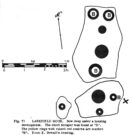Cup-and-Ring Stone (destroyed): OS Grid Reference – NS 2295 7591
Also Known as:
Archaeology & History
When the moorland here was still free from the dodgy factory workings of Texas Instruments (UK) Ltd, a Mr F. Newall (1960) came across this curious example of ancient rock art—now long gone. He described the find as,
“A series of cup marks and one ring, worked in laminated sandstone (that) has been located on Larkfield Moor by Mr H.M. Sinclair. In several cases the outer edge of the cup has been deeply incised through yellow sandstone to leave a slightly raised boss of red sandstone at the centre. From the side of the outcrop bearing the cups was recovered a chert scraper, doubly notched on one edge.”

The “chert scraper” is marked on the adjacent diagram with an “X”.
Although this carving is described on the latest Canmore survey as being “possibly a freak geological formation”, we are best erring on the side of caution regarding their note. The cup-marks on this stone were—as the illustration (right) shows—quite large, which is the reason for the geophysical suggestion. However, the site was deemed to be authentic by the rock art authority R.W.B. Morris. (1981) In his account of this petroglyph, Morris told of there being,
“6 rings up to 20cm (8in) diameters, cut so that they penetrated the next lower yellow sandstone layer; but in 4 cases having a ‘boss’ of red sandstone slightly raised in the middle, and also 3 cups. Greatest carving depth 1cm (½ in).”
References:
- Morris, Ronald W.B., “The Cup-and-Ring Marks and Similar Sculptures of South-West Scotland,” in Transactions of the Ancient Monuments Society, volume 14, 1967.
- Morris, Ronald W.B., The Prehistoric Rock Art of Southern Scotland, BAR: Oxford 1981.
- Morris, Ronald W.B. & Bailey, Douglas C., “The Cup-and-Ring Marks and Similar Sculptures of Southwestern Scotland: A Survey,” in Proceedings of the Society of Antiquaries, Scotland, volume 98, 1966.
- Newall, F., “Larkfield Moor,” in Discovery & Excavation, Scotland, 1960.
© Paul Bennett, The Northern Antiquarian
The map could not be loaded. Please contact the site owner.